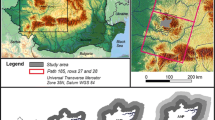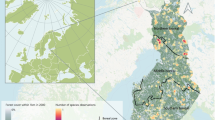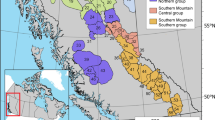Abstract
Caucasian black grouse (Tetrao mlokosiewiczi) is on the ‘red’ list of species of high conservation concern as nearest threatened (NT) and also in level (I) of Convention on International Trade in Endangered Species of Wild Fauna and Flora (CITES). The black grouse distribution range in Iran is restricted to the Arasbaran region, Northwest of Iran, and the populations and range of this specialist bird species have been declining over the last decades. Management of forest and grassland structures is important for black grouse population survival. The main goals of this study were to monitor and quantify the landscape pattern changes in Caucasian black grouse habitat in the Arasbaran biosphere reserve in two periods of 14 years (1987–2001) and 10 years (2001–2011). For quantifying landscape pattern changes, various landscape metrics were derived by spatial analysis software FRAGSTATS 3.3, including NP (number of habitat patches), LPI (largest patch index) and TE (total edge). The results indicated that the proportion of forest decreased from 39.95 to 31.95 % and the proportion of grassland decreased from 44.45 to 38.44 % in the 24-year span. NP of forests increased in the first period and decreased in the second period of study. TE of dense forest at altitude above 1800 m decreased. Reduction of forest edge is an indicator of reduction in habitat availability for Caucasian black grouse which use the forest edge for living, lekking and hatching in upland. Our results provided quantitative data on habitat loss and fragmentation in the Arasbaran biosphere reserve and indicated negative impacts of the landscape structure changes on Black grouse habitat.






Similar content being viewed by others
References
Alijanpour, A. (2013). Effect of physiographic factors on qualitative and quantitative characteristics of Cornus mas L. natural stands in Arasbaran forests, Iran. Journal of Forestry Research, 24(1), 69–74.
Baskaya, S. (2003). Distribution and principal threats to Caucasian black grouse Tetrao mlokosiewiczi in the Eastern Karadeniz Mountains in Turkey. Wildlife Biology, 9, 377–383.
Behboody, A. H. (1995). The analysis of rare species of birds and plants condition. Tabriz, DC:The publications of the Centre of Scientific and Industrial Research of East Azerbaijan.
BirdLife International (2012). Lyrurus mlokosiewiczi. The IUCN Red List of Threatened Species. Version 2014.2. <www.Iucnredlist.org>. Downloaded on 09 August 2014.
Birdlife International (2014). Endemic bird area factsheet: Caucasus. Downloaded from http://www.birdlife.org on 02.08.2014.
Bodart, C., Eva, H., Beuchle, R., Rasi, R., Simonetti, D., Stibig, H. J., Brink, A., Lindquist, E., & Achard, F. (2011). Pre-processing of a sample of multi-scene and multi-date Landsat imagery used to monitor forest cover changes over the tropics. ISPRS Journal of Photogrammetry and Remote Sensing, 66(5), 555–563.
Bolliger, J., Battig, M., Gallati, J., Klay, A., Stauffacher, M., & Kienast, F. (2011). Landscape multifunctionality: a powerful concept to identify effects of environmental change. Regional Environmental Change, 11, 203–206.
Broadbent, E. N., Zambrano, A. M. A., Dirza, R., Durham, W. H., Driscoll, L., Gallagher, P., Salters, R., Schultz, J., Colmenares, A., & Randolph, S. G. (2012). The effect of land use change and ecotourism on biodiversity: a case study of Manuel Antonio, Costa Rica, from 1985 to 2008. Landscape Ecology, 27, 731–744.
Buchmann, C. M., Schurr, F. M., Nathan, R., & Jeltsch, F. (2013). Habitat loss and fragmentation affecting mammal and bird communities—the role of interspecific competition and individual space use. Ecological Informatics, 14, 90–98.
Burns, P., & Nolin, A. (2014). Using atmospherically-corrected Landsat imagery to measure glacier area change in the cordillera Blanca, Peru from 1987 to 2010. Remote Sensing of Environment, 140, 165–178.
Cook, W. M., Lane, K. T., Foster, B. L., & Holt, R. D. (2002). Island theory, matrix effects and species richness patterns in habitat fragments. Ecology Letters, 5, 619–623.
Cushman, S. A., McGarigal, K., & Neel, M. C. (2008). Parsimony in landscape metrics: strength, universality and consistency. Ecological Indicators, 8, 691–703.
Debinski, D. M., & Holt, R. D. (2000). A survey and overview of habitat fragmentation xperiments. Conservation Biology, 14, 342–355.
Ebrahimi, S. S., Pourbabaei, H., Potheir, D., Omidi, A., & Torkaman, J. (2014). Effect of livestock grazing and human uses on herbaceous species diversity in oriental beech (Fagus orientalis Lipsky) forests, Guilan, Masal, northern Iran. Journal of Forestry Research, 25(2), 455–462.
Falcucci, A., Maiorano, L., & Boitani, L. (2007). Changes in land-use/land-cover patterns in Italy and their implications for biodiversity conservation. Landscape Ecology, 22, 617–631.
Fauth, P. T., Gustafson, E. J., & Robenold, K. N. (2000). Using landscape metrics to model source habitat for Neotropical migrants in the Midwestern U.S. Landscape Ecology, 156, 621–631.
Goodwin, B. J., & Fahrig, L. (2002). How does landscape structure influence landscape connectivity? Oikos, 99, 552–570.
Habel, J. C., & Zachos, F. E. (2012). Habitat fragmentation versus fragmented habitats. Biodiversity and Conservation, 21, 2987–2990.
Habibzadeh, N., Karami, M., & Tarinejad, A. (2010). Caucasian black grouse (Tetrao mlokosiewiczi) breeding display sites selection in Arasbaran region, East Azerbaijan, Iran. Russian Journal of Ecology, 41(5), 450–457.
Hansen, M. C., & Loveland, T. R. (2012). A review of large area monitoring of land cover change using landsat data. Remote Sensing of Environment, 122, 66–74.
Hanski, I. (1999). Metapopulation ecology. Oxford.:Oxford University Press.
Hargis, C. D., Bissonette, J. A., & David, J. L. (1998). The behavior of landscape metrics commonly used in the study of habitat fragmentation. Landscape Ecology, 13, 167–186.
Herzfeld, U. C., Matassa, M. S., & Mimler, M. (1999). TRANSVIEW: a program for matching Universal Transverse Mercator (UTM) and geographic coordinates. Computers and Geosciences, 25(7), 765–773.
Joshi, J., Stoll, P., Rusterholz, H. P., Schmid, B., Dolt, C., & Baur, B. (2006). Small-scale experimental habitat fragmentation reduces colonization rates in species-rich grassland. Oecologia, 148, 144–152.
Kareiva, P., & Wennergren, U. (1995). Connecting landscape patterns and population processes. Nature, 373, 299–302.
Kurki, S., Nikula, A., Helle, P., & Lindén, H. (2000). Landscape fragmentation and forest composition effects on grouse breeding success in boreal forests. Ecology, 81, 1985–1997.
Lechner, A. M., Reinke, K. J., & Lucy Bastin, Y. W. (2013). Interactions between land cover pattern and geospatial processing methods: effects on landscape metrics and classification accuracy. Ecological Complexity, 15, 71–82.
Li, C., Li, J., & Wu, J. (2013). Quantifying the speed, growth modes, and landscape pattern changes of urbanization: a hierarchical patch dynamics approach. Landscape Ecology, 28, 1875–1888.
Lian, X., Zhang, T., Cao, Y., Su, J., & Thirgood, S. (2011). Road proximity and traffic flow perceived as potential predation risks: evidence from the Tibetan antelope in the Kekexili National Nature Reserve, China. Wildlife Research, 38, 141–146.
Lienert, J., Fischer, M., Schneller, J., & Diemer, M. (2002). Isozyme variability of the wetland specialist Swertia perennis (Gentianaceae) in relation to habitat size, isolation, and plant fitness. American Journal of Botany, 89, 801–811.
Liu, X., Li, Y., Shen, J., Fu, X., Xiao, R., & Wu, J. (2014). Landscape pattern changes at a catchment scale: a case study in the upper jinjing river catchment in subtropical central China from 1933 to 2005. Landscape and Ecological Engineering, 10, 263–276.
Ludwig, T., Storch, I., & Gartner, S. (2009). Large-scale land use change may explain bird species declines in semi-natural areas : the case of black grouse population collapse in Lower Saxony, Germany. Journal of Ornithology, 150, 871–882.
Majnoonian, H., Jamshid, M., & Bahram, Z. (1983). The report of compositional and structural of black grouse inhabitation plant cover. Tehran, DC:Research project of Iran’s wildlife.
Makki, T., Fakheran, S., Moradi, H., Iravani, M., & Senn, J. (2013). Landscape-scale impacts of transportation infrastructure on spatial dynamics of two vulnerable ungulate species in Ghamishloo Wildlife Refuge, Iran. Ecological Indicators, 31, 6–14.
Malavasi, M., Santoro, R., Cutini, M., Acosta, A. T. R., & Carranza, M. L. (2013). What has happened to coastal dunes in the last half century? A multitemporal coastal landscape analysis in Central Italy. Landscape and Urban Planning, 119, 54–63.
Masoud M (1993) Evaluation of population of black grouse in the Mazgar village region and the analysis of black grouse inhabitation (the KALAN core zone), Tabriz, DC: Report of the environment protection administration of East Azerbaijan.
Masoud, M. (1995). A survey of finding black grouse inhabitation in west free regions. Tabriz, DC:Report of the environment protection administration of East Azerbaijan.
Masoud M (2004a). The translation of behavioural biology of black grouse. Tabriz, DC: Publication of ornithology laboratory of republic of Azerbaijan.
Masoud M (2004b). The analysis of distribution of Caucasian black grouse population, Tetrao mlokosiewiczi in East Azerbaijan region. Tabriz, DC: Report of the environment protection administration of East Azerbaijan.
McAlpine, C. A., & Eyre, T. G. (2002). Testing landscape metrics as indicators of habitat loss and fragmentation in continuous eucalypt forests (Queensland, Australia). Landscape Ecology, 17, 711–728.
McGarigal K (2004). Fragstats: spatial pattern analysis program for quantifying landscape structure. General Technical Report PNW-GTR-351. USDA Forest Service, Pacific Northwest Research Station, Portland.
Nixon, K., Silbernagel, J., Price, J., Miller, N., & Swaty, R. (2014). Habitat availability for multiple avian species under modeled alternative conservation scenarios in the two Hearted River watershed in Michigan, USA. Journal for Nature Conservation, 22(4), 302–317.
Plexida SG, Sfougaris AI, Ispikoudis IP, Papanastasis VP (2014). Selecting landscape metrics as indicators of spatial heterogeneity—a comparison among Greek landscapes. International Journal of Applied Earth Observation and Geoinformation, 26, 26–35.
Pons, X., Pesquer, L., Cristobal, J., & Guerrero, O. G. (2014). Automatic and improved radiometric correction of Landsat imagery using reference values from MODIS surface reflectance images. International Journal of Applied Earth Observation and Geoinformation, 33, 243–254.
Ramezani, H., & Grafstrom, A. (2014). A comparison of two procedures estimate three basic monitoring landscape metrics for monitoring. Environmental Monitoring and Assessment, 186, 4709–4718.
Rasuly, A. (2009). Principles of applied remote sensing: satellite image processing. Tabriz University Press, Iran.
Rasuly, A., Naghdifar, R., & Rasuly, M. (2010). Detecting of Arasbaran forest changes applying image processing procedures and GIS techniques. Procedia Environmental Sciences, 2, 454–464.
Said, S., & Servanty, S. (2005). The influence of landscape structure on female roe deer home-range size. Landscape Ecology, 20, 1003–1012.
Salvati, L., Tombolini, H., Pwrini, L., & Ferrara, A. (2013). Landscape changes and environmental quality: the evolution of land vulnerability and potential resilience to degradation in Italy. Regional Environmental Change, 13, 1223–1233.
Samuel, C., Kevin, M., & Maile, N. (2008). Parsimony in landscape metrics: strength, universality, and consistency. Ecological Indicators, 8, 691–703.
Sekercioglu, C. H., Anderson, S., Akcay, E., Bilgin, R., Can, O. E., Semiz, G., Tavsanoglu, C., Yokes, M. B., Soyumert, A., Ipekdal, K., Saglam, I. K., Yucel, M., & Dalfes, H. N. (2011). Turkey’s globally important biodiversity in crisis. Biological Conservation, 144, 2752–2769.
Shahbazi, F., Jafarzadeh, A. A., & Shahbazi, M. R. (2009). Agro-ecological field vulnerability evaluation and climate change impacts in Souma area (Iran), using MicroLEIS DSS. Biologia, 64(3), 555–559.
Sobanski, N., & Marques, M. C. M. (2014). Effects of soil characteristics and exotic grass cover on the forest restoration of the Atlantic forest region. Journal for Nature Conservation, 22(3), 217–222.
Tan, B., Masek, J. G., Wolfe, R., Gao, F., Huang, C., Vermote, E. F., Sexton, J. O., & Ederer, G. (2013). Improved forest change detection with terrain illumination corrected Landsat images. Remote Sensing of Environment, 136, 469–483.
Tangestani MH, Moore F (2000). Iron oxide and hydroxyl enhancement using the crosta method: a case study from the Zagros belt, Fars province, Iran. International Journal of Applied Earth Observation and Geoinformation, 2(2), 140–146.
Thomas, K., Ekschmitt, K., Isfendyaroglu, S., & Gem, E. (2007). Assessing the potential distribution of the Caucasian black grouse (tetrao mlokosiewiczi) in Turkey through spatial modeling. Journal of Ornithology, 148, 427–434.
Tischendorf, L., Bender, D. J., & Fahrig, L. (2003). Evaluation of patch isolation metrics in mosaic landscapes for specialist vs. generalist dispersers. Landscape Ecology, 18, 41–50.
Torahi, A. A., & Rai, S. C. (2013). Modeling for prediction of land cover changes based on bio-physical and human factors in Zagros Mountains, Iran. Journal of the Indian Society of Remote Sensing, 41(4), 845–854.
Torres, R., Gasparri, N. I., Blendinger, P. G., & Grau, H. R. (2014). Land use and land cover effects on regional biodiversity distribution in a subtropical dry forest: a hierarchical integrative multi-taxa study. Regional Environmental Change, 14, 1541–1561.
Vanonckelen, S., Lhermitte, S., & Rompaey, A. V. (2013). The effect of atmospheric and topographic correction methods on land cover classification accuracy. International Journal of Applied Earth Observation and Geoinformation, 24, 9–21.
Wegge, P., & Kastdalen, L. (2008). Habitat and diet of young grouse broods: resource partitioning between Capercaillie (Tetrao urogallus) and black grouse (Tetrao tetrix) in boreal forests. Journal of Ornithology, 149, 237–244.
Wegge, P., & Rolstad, J. (2011). Clear cutting forestry and Eurasian boreal forest grouse: long-term monitoring of sympatric capercaillie Tetrao urogallus and black grouse T. tetrix reveals unexpected effects on their population performances. Forest Ecology and Management, 261, 1520–1529.
Wu, J., Shen, W., Sun, W., & Tueller, P. T. (2002). Empirical pattern of the effects of changing scale on landscape metrics. Landscape Ecology, 17, 761–782.
Wu, Q., Li, H. Q., Wang, R. S., Paulussen, J., He, Y., Wang, M., Wang, B. H., & Wang, Z. (2006). Monitoring and predicting land use change in Beijing using remote sensing and GIS. Landscape and Urban Planning, 78, 322–333.
Xiao, L. C., Hong-Mei, Z., Ping-Xiang, L., & Zhi-Yong, Y. (2006). Remote sensing image-based analysis of the relationship between urban heat island and land use/cover changes. Remote Sensing of Environment, 104, 133–146.
Zhang, L., Xu, W., Ouyang, Z., & Zhu, C. (2014). Determination of priority nature conservation areas and human disturbances in the Yangtze river basin, China. Journal for Nature Conservation, 22(4), 326–336.
Zhang, W. W., Yao, L., Li, H., Sun, D. F., & Zhou, L. D. (2011). Research on land use change in Beijing Hanshiqiao Wetland Nature Reserve using remote sensing and GIS. Procedia Environmental Sciences, 10, 583–588.
Zohmann, M., Immitzer, M., Woss, M., Gossow, H., & Nopp-Mayr, U. (2014). Modeling habitat use of Tetrao urogallus L. in Austria for conservation issues. Journal for Nature Conservation, 22(3), 223–234.
Author information
Authors and Affiliations
Corresponding author
Rights and permissions
About this article
Cite this article
Darvishi, A., Fakheran, S. & Soffianian, A. Monitoring landscape changes in Caucasian black grouse (Tetrao mlokosiewiczi) habitat in Iran during the last two decades. Environ Monit Assess 187, 443 (2015). https://doi.org/10.1007/s10661-015-4659-3
Received:
Accepted:
Published:
DOI: https://doi.org/10.1007/s10661-015-4659-3




